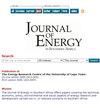International procurement policies influencing renewable energy siting – implications for South Africa
IF 0.6
4区 工程技术
Q4 ENERGY & FUELS
引用次数: 0
Abstract
The South African Renewable Independent Power Producer Procurement Programme selects bid winners based on bid tariff (70% weighting) and various economic development criteria (30% weighting). Locating renewable energy (RE) projects in areas with better resources increases their cost competitiveness. As a result, most successful bids for wind and solar photovoltaic (PV) systems to date have been concentrated in the Eastern Cape and Northern Cape provinces, respectively. Studies have shown that a wider geographic distribution of wind and solar PV projects mitigates the impacts of the variability of wind and solar PV resources, eases grid congestion and generally improves the power system’s operation. This paper conducts a literature review to investigate the procurement methods used in different regions of the world to influence the placement of RE plants, the results of which then inform proposals on adjustments to the current REI4P. The study finds that, after congestion incidents due to concentration of RE plants, some regions implement location-based tariff, where high-resource areas receive the lowest tariff and vice versa. Other regions prioritise on building transmission infrastructure in high-resource areas, while others limit the size of RE installations in one area. Given the current generation and transmission constraints in South Africa, it is important to encourage geographical dispersion of RE plants and avoid RE curtailment, since this can escalate the cost of RE integration significantly.影响可再生能源选址的国际采购政策——对南非的启示
南非可再生能源独立电力生产商采购计划根据投标电价(70%权重)和各种经济发展标准(30%权重)选择中标企业。将可再生能源(RE)项目选址在资源较好的地区可以提高其成本竞争力。因此,迄今为止最成功的风能和太阳能光伏(PV)系统投标分别集中在东开普省和北开普省。研究表明,扩大风能和太阳能光伏项目的地理分布,可以减轻风能和太阳能光伏资源可变性的影响,缓解电网拥堵,总体上改善电力系统的运行。本文进行了文献综述,以调查世界不同地区用于影响可再生能源工厂安置的采购方法,其结果然后为当前REI4P的调整建议提供信息。研究发现,在发生可再生能源电厂集中拥堵事件后,部分地区实行基于位置的电价,资源丰富的地区电价最低,资源丰富的地区电价最低。其他地区优先考虑在资源丰富的地区建设输电基础设施,而其他地区则限制在一个地区安装可再生能源的规模。鉴于南非目前的发电和输电限制,鼓励可再生能源工厂在地理上分散并避免削减可再生能源非常重要,因为这可能会大大增加可再生能源整合的成本。
本文章由计算机程序翻译,如有差异,请以英文原文为准。
求助全文
约1分钟内获得全文
求助全文
来源期刊

Journal of Energy in Southern Africa
ENERGY & FUELS-
CiteScore
3.00
自引率
0.00%
发文量
16
审稿时长
6 months
期刊介绍:
The journal has a regional focus on southern Africa. Manuscripts that are accepted for consideration to publish in the journal must address energy issues in southern Africa or have a clear component relevant to southern Africa, including research that was set-up or designed in the region. The southern African region is considered to be constituted by the following fifteen (15) countries: Angola, Botswana, Democratic Republic of Congo, Lesotho, Malawi, Madagascar, Mauritius, Mozambique, Namibia, Seychelles, South Africa, Swaziland, Tanzania, Zambia and Zimbabwe.
Within this broad field of energy research, topics of particular interest include energy efficiency, modelling, renewable energy, poverty, sustainable development, climate change mitigation, energy security, energy policy, energy governance, markets, technology and innovation.
 求助内容:
求助内容: 应助结果提醒方式:
应助结果提醒方式:


